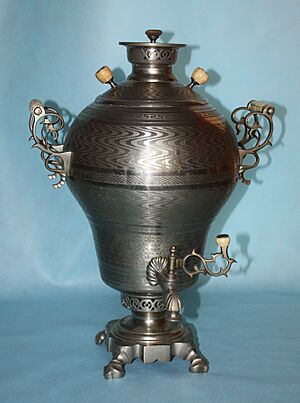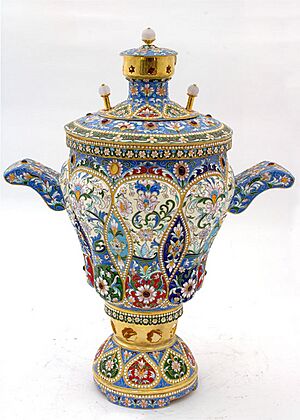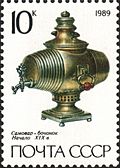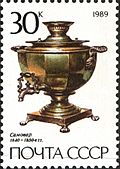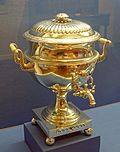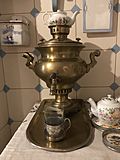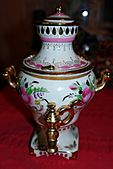Samovar facts for kids
A samovar is a special metal pot used to heat and boil water. The word "samovar" comes from Russian and means "self-brewer". Even though it started in Russia, people all over Eastern Europe, Western Asia, Central Asia, and South Asia also know and use samovars.
Most of the time, the hot water from a samovar is used to make tea. Many samovars have a special ring on top. This ring holds a teapot filled with strong tea, keeping it warm. In the past, samovars were heated with coal or small pieces of wood. Today, many new samovars use electricity, just like an electric water boiler. Old samovars are often valued for their beautiful designs.
Contents
What is a Samovar?
Samovars are usually made from metals like iron, copper, polished brass, bronze, silver, gold, tin, or nickel.
A typical samovar has several parts:
- A main body
- A base and a chimney (a pipe inside)
- A cover and a steam vent
- Handles
- A tap and a key to turn it
- A crown and a ring on top
- A chimney extension and a cap
- A drip-bowl to catch spills
- A place for a teapot
The body of a samovar can be shaped like an urn, a barrel, a cylinder, or a ball. They come in many sizes, from very large ones used for many people to smaller ones for families. Some hold about 4 liters (about 1 gallon) of water, while others are as small as 1 liter.
A traditional samovar has a large metal pot with a tap at the bottom. A metal pipe goes straight up through the middle. This pipe is where you put solid fuel, like charcoal. When you light the fuel, it heats the water around the pipe. A small chimney, about 15 to 20 centimeters (6 to 8 inches) tall, is placed on top. This helps the fire burn better.
Once the water boils and the fire goes out, you can take off the small chimney. Then, a teapot is placed on top. The hot air rising from the samovar keeps the teapot warm. This teapot holds a strong tea concentrate called zavarka. To serve the tea, you mix a little of this strong tea with a lot of hot water from the samovar. Usually, it's about 1 part tea to 10 parts water, but people can mix it how they like.
History of the Samovar
We don't know exactly when or where the samovar first appeared before the 1700s. Some people think it might be connected to an old Greek water-heater called an autepsa. This was a vase with a tube in the middle for coal. Russian samovars were likely influenced by cultures from the Byzantine Empire and Central Asia. In turn, Russian culture also influenced these regions.
In 1989, "samovar-like" pottery was found in Shaki, Azerbaijan. It was thought to be at least 3,600 years old! This old pot had a tube inside to help heat the water, similar to a modern samovar. However, it needed an outside fire to work, unlike today's samovars that carry their own fuel.
The First Samovar Makers
The first samovar makers we know about were the Russian Lisitsyn brothers, Ivan and Nazar. They learned metalworking from their father. In 1778, they made a samovar. That same year, Nazar Lisitsyn opened Russia's first samovar factory. They might not have invented the samovar, but they were the first to make them in a factory. Their beautiful designs became very popular.
These early makers lived in Tula. This city was famous for its metalworkers and people who made weapons. Since the 1700s, Tula has been the main place where samovars are made in Russia. A "Tula samovar" is a special brand from the city. There's a Russian saying, "to travel to Tula with one's own samovar." It means doing something that isn't needed, like "carrying coal to Newcastle" (bringing coal to a place that already has a lot of it).
Over time, samovar makers appeared all over Russia. By the 1800s, samovars were a common part of Russian tea culture. Many were made and sent to Central Asia and other places.
Samovars in Daily Life
The samovar was very important in Russian homes and taverns for drinking tea. Everyone used them, from the poorest farmers to the richest people. The Russian saying "to have a sit by the samovar" means to have a relaxed chat while drinking tea.
In the past, samovars were a cheap way to always have hot water. You could use slow-burning things like charcoal or dry pinecones as fuel. When not in use, the fire in the samovar pipe would just smolder slowly. If you needed hot water quickly, you could use bellows to make the fire burn faster. Sometimes, a Russian jackboot (a type of boot) was even used for this! Today, samovars are popular gifts for tourists visiting Russia.
-
Baroque samovar from the 1700s, shown on a 1989 USSR stamp
-
Samovar made from ceramic (Gzhel style)
-
Samovar in a museum in Tomsk
Samovars Around the World
The Russian word "samovar" has been adopted into other languages, like "samovar" in Persian and "semaver" in Turkish.
Iran
Samovars have been used in Iran for at least 200 years. This started when Russia and Iran began to have closer ties. Today, electric, oil-burning, or natural gas samovars are still common in Iran. Iranian artists have added Persian art designs to their samovars.
The Iranian city of Borujerd has been a main center for making samovars. Some workshops there still make them by hand. Borujerd's samovars are often made with German silver and have a special art style called Varsho-Sazi. These artistic samovars from Borujerd are often shown in museums as examples of Iranian art and crafts.
Kashmir
Samovars in Kashmir are made of copper and have beautiful engraved designs. In Kashmir, there were two main types of samovars. Muslims used copper samovars, while local Hindus (called Kashmiri Pandit) used brass ones. The brass samovars were coated with nickel inside.
Inside a Kashmiri samovar, there is a fire container where charcoal and hot coals are placed. Around this container, there is space for water to boil. To make tea, green tea leaves, salt, cardamom, and cinnamon are added to the water.
Turkey
Turkish samovars are popular souvenirs for tourists. Samovars that burn charcoal are still used in outdoor areas. However, in modern homes, samovars have mostly been replaced by the çaydanlık. This is a metal teapot with a smaller teapot placed on top, where the samovar's cap would be.
To make Turkish tea, the bottom part of the çaydanlık is used to boil water. The top part, called demlik, holds strong tea concentrate. You pour tea from the demlik first, and then add plain hot water from the bottom kettle to make it the strength you like. Çaydanlık are traditionally made of brass or copper, and sometimes silver or gold. Now, they are also made from stainless steel, aluminum, or ceramics, with plastic, steel, or aluminum handles.
Images for kids
See also
 In Spanish: Samovar para niños
In Spanish: Samovar para niños


